WET Manager
The WET Manager is the gateway for WET applications. It is
from here that a tester has to launch the various utilities of WET.
Simulated IE
A simulated IE is a windows application that looks similar to an
IE browser. However the simulated browser cannot be used to navigate
to web sites directly. It can only connect to IE browsers that
are already open. Likewise the tester cannot perform any operation
directly in the simulated browser. Instead a context sensitive popup
menu is provided using which the tester 'instructs' that certain
operations must be performed. These 'instructions' are used to
generate scripts and create object depots.
|
Recomendation level :- Medium.
Although the IE simulated browser does provide a fairly
accurate representation of the actual Web page for most simple
web pages, it is not guaranteed to work for all Web applications.
When you start using your Application under test, if you find
that pages have a distorted view or certain elements on the
simulated browser do not correspond to the corresponding element
in the real browser, then we suggest that you switch to using the
Wet Treeview.
|
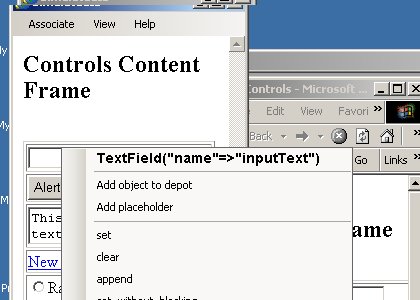
Illustration
1: Screenshot of the WET Manager
WET Simulated View :
|
Recomendation
level :- Low.
The view rendered by the WET
Simulated browser is not similar to the real browser's view. Each
element in this view is rendered by WET itself. The only
advantage of using this view is that all elements shown on the
real browser that can be automated are represented here (nothing
is missed)
We do not recommend the use of
this browser view. If the IE Simulated Browser doesn't work for
your application,then use the WET Treeview.
|
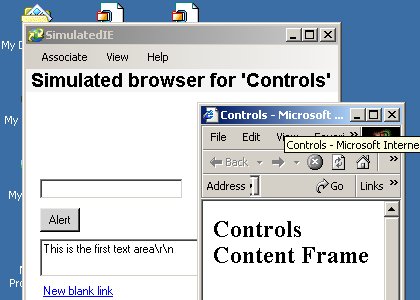
Illustration
2: Screenshot of wet simulated browser
WET TreeView :
|
Chef Recommends!!
(Recomendation level :-
Very high)
This is by far the most accurate
view when it comes to identifying objects for creating WET
Scripts. All 'WET scriptable' objects on the actual IE browser
are shown in this view. The only caveat is that this view is not
a simulated view - rather the elements are shown using a treeview
notion.
|
The WET Treeview is a windows application in which all the
elements of the treeview are displayed in a hierarchical manner using
a treeview. In this view, you can then perform various operations
like setting text, clicking, etc., These operations are automatically
converted to corresponding WET scripts and when applicable, the
object depot is also updated. The treeview has the ability to display
only 'fitlered' items (for ex. only textfields)
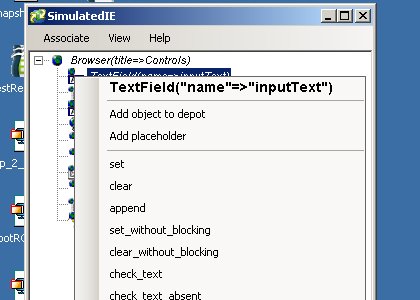
Illustration
3: Screenshot of the WET Treeview
Object
Depot Manager
Using Object Depots, the elements used for WET Automation scripts
can all be stored in one or more centralized locations. To learn more
about the concept of Object depots see this article .
The Object depot manager is an application which allows the user to
edit these object depot files. Using the WET Object Depot Manager,
one can create object depots entirely by hand or create object depots
by performing various operations on the different browser
views(simulated / treeview). The WET Object depot manager has various
options like 'search', cut, copy and paste which makes this as a
powerful upgrade to the old XML Repository Manager application.
.
The Object depot manager is an application which allows the user to
edit these object depot files. Using the WET Object Depot Manager,
one can create object depots entirely by hand or create object depots
by performing various operations on the different browser
views(simulated / treeview). The WET Object depot manager has various
options like 'search', cut, copy and paste which makes this as a
powerful upgrade to the old XML Repository Manager application.

Illustration
4: Object Depot Manager
Test
Definition Editor
The test definition editor application is used to create test
definition files that can be used in WET automation. The test
definition Editor in version 1.0 does not try to do anything smart.
It acts as a (almost) dumb editor. For example, when you set the
object depot file or transaction path using the test definition
editor, then it does not try to check if the file exists or not and
in case the file doesn't exist, it doesn't try to create one for you.
Instead, it simply creates a test definition file using the 'Garbage
in garbage out' policy!
The test definition editor also has an abilitity to execute tests
from the UI itself. The result of test execution is then shown in a
different web browser.
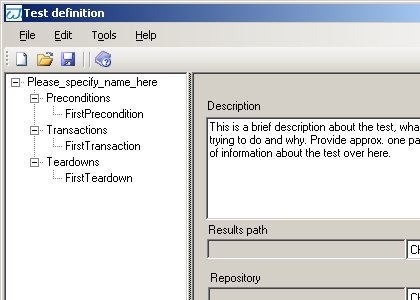
Illustration
5: Test definition editor
Script
Editor:
This is a barebones text editor to create / edit WET scripts. In
terms of its features, it probably is far less than even wordpad.
Dynamic Configuration Editor:
The dynamic configuration editor is an application used to change
the configuration settings for various WET UI operations. Please
remember that this does not edit the configuration file itself
and therefore the changes are only alive for this instance of the WET
Manager. To understand the various WET UI Configuration parameters
and to make permanant changes, See the section on UI
Configuration File .
The Dynamic configuration editor currently supports changes to two
parameters:
.
The Dynamic configuration editor currently supports changes to two
parameters:
Scripting Mode - What is the style
of generated scripts - Do the generated scripts use an object depot
or they are in the 'Full definition mode'? In the full definition
mode scripts are generated in the form,
Browser("title:=something").Frame("name:=some_name").TextField("label:=Address").set("hi
there"); Whereas in the object depot mode, the scripts
generated use an object depot. Here the scripts may appear in the
form 'object_depot("my_object").set("hi there")'.
_Default : _Object depot mode
Use Function Assistant - Whether or not we want to use the
function assistant when using the WET UI to generate scripts? If you
choose to use the function assistant, then a helper dialog box is
shown for many operations. For example, if you right click on a
textfield in the simulated browser and say set, then a dialog box
shows up where you can enter the text required to be set. If you
choose to 'not use function assistant', then no dialog box is shown.
Instead a blank placeholder script line is generated and it is upto
the tester to fill up the value required to be set. The second mode
is suitable for experts.
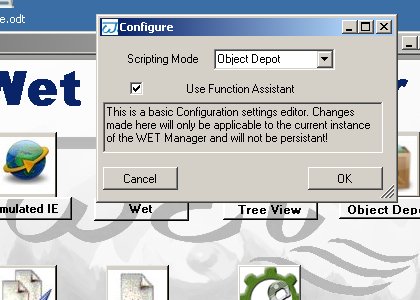
Illustration
6: Screenshot of the Configuration Mangaer
Interaction between various WET components
Even though WET 1.0 has its various components as separate
applications, it allows the tester to associate these
applications with one another. This association is required in some
cases when developing WET scripts. The following are the cases where
an association is required:
In any of the browser views
(Simulated IE, WET Simulated or Treeview), when the tester performs
action s on the simulated view, a corresponding script line must be
generated. Therefore it must be possible to associate a
browser view application with a Script editor application
Likewise, when an operation is performed on the browser view,
it may be required to create an object definition for the object on
which the action is performed. Therefore it must be possible to
associate a browser view application with an object depot
manager application
The main difference between 0.9.8 and 1.0 w.r.t the association of
various views is that in 0.9.8 this association was happenning
automatically whereas in 1.0, the tester has to explicitly specify
how this association is to be done.
How to associate applications
|
Note
Only those applications that have
been launched using the same wet manager can be associated with
each other. If a WET application is open but was not
created using the WET Manager, then such applications cannot be
associated
|
Start WET
Manager
Using the WET Manager, launch a
Wet Treeview application
Now navigate using IE to some web
page - eg. google.com
Sync the Wet Treeview application
with this IE window
Using the previously opened WET
Manager, launch an object depot manager
Using the previously opened WET
Manager, launch a Script Editor
Now in the treeview application, the first menu item is
Associate. Using this Associate menu, you can associate this
Wet Treeview with both the open 'object depot manager' and the
'Script Editor'. Now whenever you perform any operation on the
browser view, then 'associated object depot manager' and the
'associated script editor' are automatically updated.
|
WET is a opensource automated web testing tool which uses Watir as the library to drive web pages. WET drives an IE Browser
directly and so the automated testing done using WET is equivalent to how a user would drive the web pages. WET extends the
scripting abilities of Watir and also offers the convenience of recorders. It is licensed under LGPL and BSD style open source licenses.
|
|








